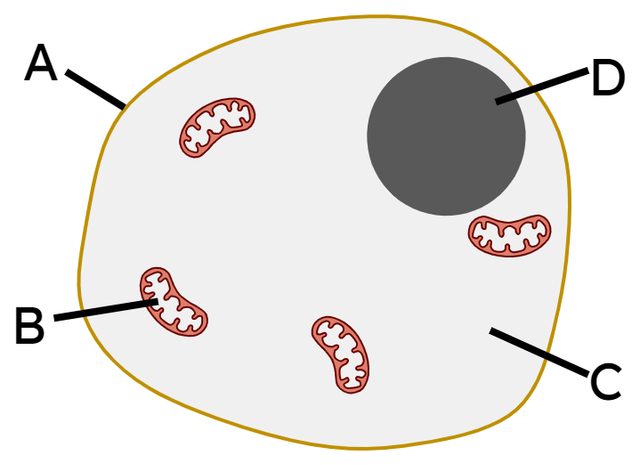Starter quiz
- All living organisms are made up of the building blocks of life. These are called...
- 'cells' ✓
 Choose the structure that controls which substances can enter and leave a cell.
Choose the structure that controls which substances can enter and leave a cell.- nucleus
- cell membrane ✓
- cytoplasm
- mitochondria
-
- The ______ contains the DNA in an animal cell and controls the cell's activities.
- 'nucleus' ✓
 In which part of an animal cell does respiration take place?
In which part of an animal cell does respiration take place?- nucleus
- mitochondria ✓
- chloroplast
- cytoplasm
-
- Plants are living organisms. Which common life processes do plants carry out at some stage in their life cycle?
- Movement ✓
- Breathing
- Nutrition ✓
- Thinking
-
 Match the letter label on the animal cell diagram to the name of the structure.
Match the letter label on the animal cell diagram to the name of the structure.- A⇔cell membrane ✓
- B⇔mitochondria ✓
- C⇔cytoplasm ✓
- D⇔nucleus ✓
Exit quiz
- All plants are made up of living building blocks called...
- 'plant cells' ✓
- Choose the structures that animal and plant cells both contain.
- chloroplast
- mitochondria ✓
- nucleus ✓
- vacuole
-
 Match the plant cell structure with a description of its function.
Match the plant cell structure with a description of its function.- Chloroplast⇔Where light is absorbed to help the plant make its food. ✓
- Vacuole⇔Contains a watery sap and helps to keep the cell firm. ✓
- Cell wall⇔Made of fibres to strengthen the cell. ✓
- Choose the structure in a plant cell that controls which substances can enter and leave the cell.
- cell wall
- cell membrane ✓
- vacuole
-
- Which structures do plant and fungi cells have that animal cells do not have?
- nucleus
- cell membrane
- cell wall ✓
- vacuole ✓
-
- In a plant cell from a root, you would not expect to find ______, as these trap light so they wouldn't be needed in cells underground.
- 'chloroplasts' ✓
Worksheet
Loading worksheet ...
Presentation
Loading presentation ...
Video
Lesson Details
Key learning points
- Plant cells have some common structures.
- Some of these structures are common with animal cells, such as the cytoplasm, cell membrane, nucleus and mitochondria.
- Plant cells have additional structures including the cell wall and vacuole, and some have chloroplasts.
- Each structure in a plant cell has a specific function.
- Plant cells can be adapted with different shapes and structures.
Common misconception
Plants are not living; plant cells all have the same shape and structures (as depicted in textbooks)
This lesson consolidates understanding that plant cells are living, and that different plant cells can have different shapes and structures.
Keywords
Cell wall - The cell wall of a plant cell is made of fibres that strengthen the cell but allow substances to pass through.
Chloroplast - Chloroplasts are structures found within cells in the green parts of a plant. They trap light to enable the plant to make its own food.
Vacuole - The vacuole of a plant cell contains watery sap which, when full, keeps the cell firm.
+